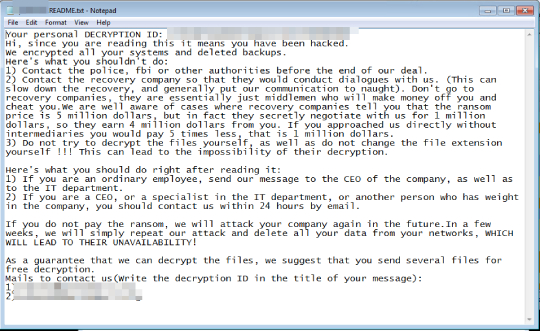Ransom.Win32.LOCKBIT.EOA
UDS:Trojan-Ransom.Win32.Lockbit.br(KASPERSKY)
Windows


Threat Type: Ransomware
Destructiveness: No
Encrypted:
In the wild: Yes
OVERVIEW
Downloaded from the Internet, Dropped by other malware
This Ransomware arrives on a system as a file dropped by other malware or as a file downloaded unknowingly by users when visiting malicious sites.
It drops files as ransom note. It avoids encrypting files with the following file extensions.
TECHNICAL DETAILS
147,968 bytes
EXE
No
Drops files, Terminates processes
Arrival Details
This Ransomware arrives on a system as a file dropped by other malware or as a file downloaded unknowingly by users when visiting malicious sites.
Installation
This Ransomware adds the following processes:
- if -safe is used:
- bcdedit /set {current} safeboot network
Process Termination
This Ransomware terminates the following services if found on the affected system:
- backup
- GxBlr
- GxCIMgr
- GxCVD
- GxFWD
- GxVss
- memtas
- mepocs
- msexchange
- sophos
- sql
- svc$
- veeam
- vss
It terminates the following processes if found running in the affected system's memory:
- agntsvc
- calc
- dbeng50
- dbsnmp
- encsvc
- excel
- firefox
- infopath
- isqlplussvc
- msaccess
- mspub
- mydesktopqos
- mydesktopservice
- notepad
- ocautoupds
- ocomm
- ocssd
- onenote
- oracle
- outlook
- powerpnt
- sqbcoreservice
- sql
- steam
- synctime
- tbirdconfig
- thebat
- thunderbird
- visio
- winword
- wordpad
- wuaclt
- xfssvccon
Other Details
This Ransomware does the following:
- If not executed with admin rights, it will attempt relaunch itself as admin by elevating its privileges via bypassing UAC
- It encrypts fixed, removable and network drives
- It deletes files in recycle bin folder for removable and fixed drives
- It uses WQL to delete shadow copies
- It deletes the following services:
- wdnissvc
- WinDefend
- wscsvc
- sppsvc
- Sense
- SecurityHealthService
- It attempts logging in to infected machine using specific sets of email and password.
It accepts the following parameters:
- -pass {value} Uses the first 32 characters of the value as key to decrypt the main routine. Required to execute properly.
- And performs only one from the following parameters:
- -safe → Reboots in safeboot
- -path {target} → Specifically encrypt the target, can be file or folder
- -gspd → Perform Group Policy Modification for Lateral Movement
- -psex → Lateral Movement via Admin Shares
- -gdel → Delete group policy updates
- -del → Delete itself
Ransomware Routine
This Ransomware avoids encrypting files with the following strings in their file name:
- autorun.inf
- boot.ini
- bootfont.bin
- bootsect.bak
- desktop.ini
- iconcache.db
- ntldr
- ntuser.dat
- ntuser.dat.log
- ntuser.ini
- thumbs.db
It avoids encrypting files found in the following folders:
- $recycle.bin
- $windows.~bt
- $windows.~ws
- all users
- boot
- config.msi
- default
- intel
- msocache
- perflogs
- program files
- program files (x86)
- programdata
- public
- system volume information
- tor browser
- windows
- windows.old
- x64dbg
It appends the following extension to the file name of the encrypted files:
- .qxzb3ZaxP
It drops the following file(s) as ransom note:
- {Encrypted Directory}\qxzb3ZaxP.README.txt

It avoids encrypting files with the following file extensions:
- 386
- adv
- ani
- bat
- bin
- cab
- cmd
- com
- cpl
- cur
- deskthemepack
- diagcab
- diagcfg
- diagpkg
- dll
- drv
- exe
- hlp
- hta
- icl
- icns
- ico
- ics
- idx
- key
- ldf
- lnk
- lock
- mod
- mpa
- msc
- msi
- msp
- msstyles
- msu
- nls
- nomedia
- ocx
- pdb
- prf
- ps1
- rom
- rtp
- scr
- shs
- spl
- sys
- theme
- themepack
- wpx
SOLUTION
9.800
18.102.05
29 Nov 2022
18.103.00
30 Nov 2022
Step 1
Trend Micro Predictive Machine Learning detects and blocks malware at the first sign of its existence, before it executes on your system. When enabled, your Trend Micro product detects this malware under the following machine learning name:
- Troj.Win32.TRX.XXPE50FFF062
Step 2
Before doing any scans, Windows 7, Windows 8, Windows 8.1, and Windows 10 users must disable System Restore to allow full scanning of their computers.
Step 3
Note that not all files, folders, and registry keys and entries are installed on your computer during this malware's/spyware's/grayware's execution. This may be due to incomplete installation or other operating system conditions. If you do not find the same files/folders/registry information, please proceed to the next step.
Step 4
Search and delete these files
- {Encrypted Directory}\qxzb3ZaxP.README.txt
Step 5
Scan your computer with your Trend Micro product to delete files detected as Ransom.Win32.LOCKBIT.EOA. If the detected files have already been cleaned, deleted, or quarantined by your Trend Micro product, no further step is required. You may opt to simply delete the quarantined files. Please check the following Trend Micro Support pages for more information:
Step 6
Restore encrypted files from backup.
Did this description help? Tell us how we did.

